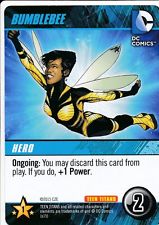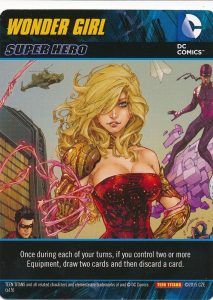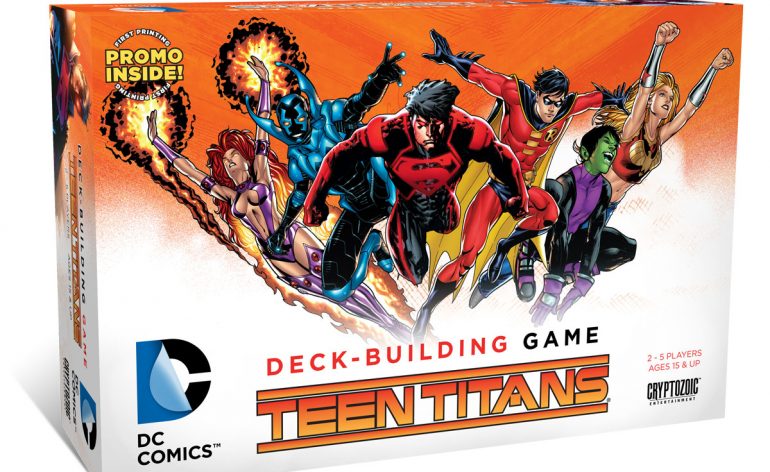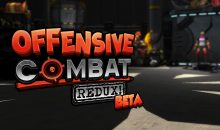DC Deck Building: Teen Titans
 The first game was over before it really began. By the third round of DC Deck-Building Game: Teen Titans, my SO had picked up Shimmer, a four-cost villain that gives opponents a Weakness card with every attack. While Teen Titans has more defense cards than some of the other sets in the DC Deck-Building universe, I hadn’t picked one up yet that game. Round after round I took Weaknesses. While my superhero (Wonder Girl) gave me bonuses if I had two Equipment cards on the table, I was never able to take advantage of her powers. By the time my SO had collected her fourth straight supervillain, she was so far ahead in points that I mercifully conceded the game to her.
The first game was over before it really began. By the third round of DC Deck-Building Game: Teen Titans, my SO had picked up Shimmer, a four-cost villain that gives opponents a Weakness card with every attack. While Teen Titans has more defense cards than some of the other sets in the DC Deck-Building universe, I hadn’t picked one up yet that game. Round after round I took Weaknesses. While my superhero (Wonder Girl) gave me bonuses if I had two Equipment cards on the table, I was never able to take advantage of her powers. By the time my SO had collected her fourth straight supervillain, she was so far ahead in points that I mercifully conceded the game to her.
DC Deck-Building: Teen Titans is the latest standalone game in the DC Deck-Building universe. This time around, it’s the Teen Titans taking center stage, as you choose from characters such as Raven, Red Robin, or Beast Boy. The object of the game is to collect the most Victory Points, which is accomplished by collecting cards and defeating supervillains such as Dr. Light or the Clock King. Teen Titans doesn’t require any of the other sets in order to play, although fans looking for their favorite, more popular characters should look at the previous three standalone sets. You’ll find nary a Wonder Woman or Lex Luthor here.
 Anyone familiar with previous iterations of the DC Deck-Building Game will pick up the rules of this version easily enough. The biggest change to Teen Titans is the introduction of the Ongoing mechanic. Ongoing cards function like one-time locations. When played, they stay in play until needed, then discarded. Ongoing cards can stack and make for powerful burst combos. One of the new Ongoing cards is Zoo Keeper. Discarding Zoo Keeper from play avoids a single attack. Given the number of attacks that can happen in a round, it’s a solid card that comes in handy.
Anyone familiar with previous iterations of the DC Deck-Building Game will pick up the rules of this version easily enough. The biggest change to Teen Titans is the introduction of the Ongoing mechanic. Ongoing cards function like one-time locations. When played, they stay in play until needed, then discarded. Ongoing cards can stack and make for powerful burst combos. One of the new Ongoing cards is Zoo Keeper. Discarding Zoo Keeper from play avoids a single attack. Given the number of attacks that can happen in a round, it’s a solid card that comes in handy.
 On the other hand, Zoo Keeper can feel a bit too powerful, which was a problem I had with many of the Teen Titans cards. So many of the cards felt either over- or undercosted. I mentioned Shimmer before, which single-handily lost me the first game. Other cards felt like they didn’t help at all, especially that first game. At no point in the game was I able to take advantage of Wonder Girl’s effect. I never had two Equipment cards in play at the same time.
On the other hand, Zoo Keeper can feel a bit too powerful, which was a problem I had with many of the Teen Titans cards. So many of the cards felt either over- or undercosted. I mentioned Shimmer before, which single-handily lost me the first game. Other cards felt like they didn’t help at all, especially that first game. At no point in the game was I able to take advantage of Wonder Girl’s effect. I never had two Equipment cards in play at the same time.
I’ll say this for the Ongoing mechanic, it’s a definite improvement over previous iterations, especially similar mechanics in Forever Evil. Keywords can be powerful things and great shortcuts for explaining a card’s effect. If Ongoing had been introduced in Forever Evil, then maybe cards like Firestorm Matrix wouldn’t need forum posts to figure out. Ongoing does seem to replace Locations though. While they come up frequently in other DC Deck-Building sets, my SO and I didn’t play with a single Location card during either of our games.
Teen Titans also does away with two of the aspects that makes Forever Evil my favorite standalone set: the accumulation of Victory Points by other means and card destruction. There’s almost no way to collect Victory Points in Teen Titans other than buying cards from the line-up, which generally means the person with the biggest deck wins. Also, Forever Evil’s focus on destroying cards made it a true deck-builder. It’s not enough to acquire cards; you need to refine your deck as well. With the exception of one or two cards, destruction is absent from Teen Titans. This has its advantages: Teen Titans is one of the easiest iterations of the DC Deck-Building Games to teach and get into. However, it feels like a step backward from Forever Evil, in terms of strategy.
Between the lack of character recognition and the card imbalance, my overall feeling about Teen Titans is that it would make a better addition to one of the other standalone sets, rather than a set by itself.
DC Deck-Building Game: Teen Titans tl;drs
Quick summary: Grab your favorite Teen Titan and join in the fight against evil! Play as Raven, Red Robin or others and fight against the Clock King, Cheshire or other villains in a bid to get the most Victory Points and win the game.
Recommended if you like: Lightweight deck-builders, C-list enemies, combos
Better than I expected? The new Ongoing keyword simplifies text from earlier games and allows for ridiculous combos.
Worse than I hoped? Some of the cards are hilariously over- or underpowered.
Verdict: Would work better as an addition to an existing set. As a standalone it feels even breezier than other games in this franchise.
Related Reading: DC Deck-Building Game original review






